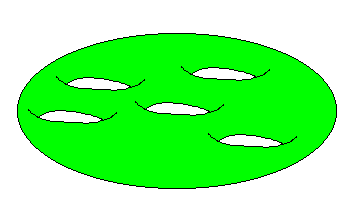
5 Arms And Beyond
Basically we could carry out the proof for the 4-arms machine to the current situation; we start from a torus representing the configuration space of the 4-arms machine. By adding a fifth arm we restrict the movement to a certain region of the torus. As in the previous case the borders of the restricted area are circles, there are exactly 22 = 4 such circles, which correspond to the 4 possible bending of the 2 arms not adjacent to the newly placed arm. Since the fifth arm has 2 possible bending there are 2 copies of the restricted region, one for each bend. The 2 regions must be connected along their borders, as states in which the fifth arm is stretched are represented on both borders. In the previous case it was not necessary to analyze how the circles (which represent the border of the restricted area) are embedded on the configuration space. Since a sphere represented the configuration of the 3-arms machine and no matter how a circle is embedded on a sphere it always divides the sphere into 2 regions, each homeomorphic to a disk. For the Torus this is not true in general, following are 2 examples of regions on a torus, which borders are, circles:
|
|
Possible case 1 |
Possible case 2 |
In each case the torus is divided into components which borders are circles and in each case 4 circle cuts were applied to the original torus. It is easy however to check that the results in both cases are not homeomorphic: The first consists of 4 connected components and the second consists of 5 connected components.
Therefore we must take further steps in order to discover how are the circles embedded on the torus, which is done in the following applet:
The configuration space of the 5-arms machine is made by connecting two components each of "Possible case 1". Below is the resulting surface: an oriented surface of genus 5.

![]()
All is left in order to find out the configuration space of the 6-arms machine is to compute: We restrict the movement of the 5-arms machine by adding a sixth arm. By Cutting 8 disks out of the genus 5 surface we end with the restricted region on the configuration space. The 8 disks correspond to 23 possible bends of the 3 arms, which are not adjacent to the newly placed arm. The same argument we used in the previous case proves that the circles, which are the borders of the restricted region, are embedded inside 4 pentagons and therefore each of these circles bounds a simple disk. By connecting two copies of the restricted regions along the 8 circles we finally come up with an oriented surface of genus 2·5+(8-1)=17. For the general formula, suppose the configuration space of an m-arms machine is an on oriented surface of genus Gm, then:
Gm+1 = 2Gm+2(m-2)-1
As a final tour of the N-arms machines, we will consider another approach to the problem of configuration spaces using the Euler Number in the next page.
![]()